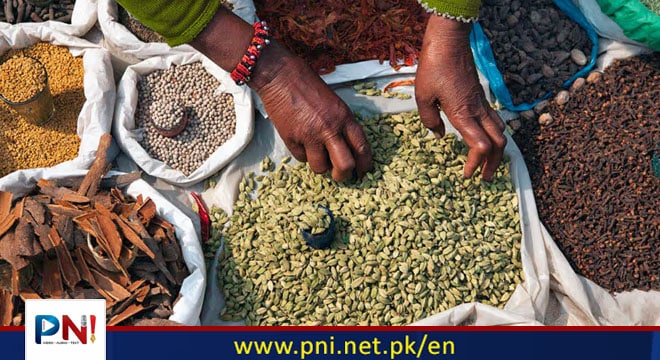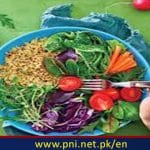ISLAMABAD, March 19 (Online): Scientists researched whether polyphenols found in foods, herbs, and spices in one’s regular diet can affect gut health.
Polyphenols are compounds found in some plant-based foods that can work as antioxidants in the body and provide protection against some diseases.
Their findings showed that the polyphenols from herbs and spices may be responsible for an increase in beneficial gut microbes.
Researchers based at the National University of Natural Medicine in Portland, Oregon recently conducted a study on whether polyphenols found in foods, herbs, and spices used in a healthy person’s typical diet could have a positive impact on gut health.
They utilized data from the International Cohort on Lifestyle Determinants of Health (INCLD HealthTrusted Source) to conduct their analysis.
The researchers learned that certain beneficial microbes such as Lactobacillusshowed an increase if participants consumed more polyphenols, and some harmful bacteria were less present in participants with a higher polyphenol intake.
The study appears in the journal Nutrients.
Polyphenols and gut bacteria
As researchers look more into how the gut impacts overall health, studiesTrusted Source show that having a healthy gut microbiome is important due to its role in digestion, immune function, skin health, and much more.
According to the National Institutes of HealthTrusted Source, the “microbiome is the collection of all microbes, such as bacteria, fungi, viruses, and their genes, that naturally live on our bodies and inside us.”
TrillionsTrusted Source of organisms live in the gut, and some things that influence the makeup of one’s gut include the environment they live in, the foods they consume, and the medications they take.
There are both good and bad types of bacteria that live in the gut. Good gut bacteria promote a healthy gut microbiome, and people can improve their good bacteria by eating fermented foods or taking probiotics.
Bad bacteria can occur in the gut, too, including bacteria such as Salmonella, which can make someone sick.
With this in mind, the authors were curious about other ways to boost gut health and took a closer look at polyphenols.
Food sources of polyphenols
PolyphenolsTrusted Source occur in many plant-based foods such as tea, fruit, vegetables, and chocolate and are connected to reduced risk of diseases such as stroke and diabetes.
The authors note that prior studies show polyphenols can be beneficial in helping create a healthy gut but say other studies have not researched whether people can get such benefits from their standard diets.
Using data from the INCLD Health study, the researchers selected a participant pool of 96 healthy adults. To qualify for inclusion, participants needed questionnaires on their eating habits and an rRNA microbiota analysis on file.
The researchers excluded people for some of the following reasons: current use of antibiotics, inflammatory bowel disease, celiac disease, or history of an autoimmune disease.
The majority of the participants were white (around 78%) and female (84.4%). Additionally, 88.5% of participants were non-smokers, and 60% reported minimal alcohol use (from 0 to 3 times per month).
The researchers measured 29 herbs and spices higher in polyphenols but noted that the participants only consistently consumed six. The herbs and spices they focused on were:
black pepper
onion
garlic
cinnamon
ginger
turmeric
Only one of the spices – cinnamon – fell into the category of the highest polyphenol count at equal to or greater than 3,000 mg/kg DW. The most frequently used spice was black pepper, which had a midlevel category polyphenol count of 1,000-1,999 mg/kg DW.
Participants reported higher intakes of garlic and onion, but both were categorized in the lower level of polyphenol counts, less than 1000 mg/kg DW.
The scientists next placed the participants into groups based on their estimated polyphenol exposure through the foods they reported consuming. The groups include low-consumer, medium-consumer, and high-consumer.
More good gut bacteria with higher polyphenol intake
The researchers then analyzed the 16s rRNA microbiota gene sequencing data extracted from microbial DNA from participant stool samples.
According to the researchers, they “first explored potential microbial biomarkers of polyphenol exposure and then used these identified biomarkers in more targeted statistical comparisons.”
After identifying microbial taxa connected to polyphenols, the researchers examined the microbial communities of each polyphenol exposure group to see what connections they could make.
The analysis showed that microbial diversity was consistent amongst all groups regardless of whether the participants were in low or high-consumption groups. However, the researchers did note some differences with specific microbial taxa.
With the bacterium Lactobacillus, they saw a connection between the groups with higher polyphenol intake and an abundance of these good bacteria. Lactobacillus helps prevent intestinal damage.
The scientists also noted a reduction in harmful bacteria in the high-consumption group and noted “opportunistic and pro-inflammatory bacteria are represented in a lower relative abundance.”
“Our results suggest that higher quantities of habitual polyphenol consumption may support an intestinal environment where opportunistic and pathogenic bacteria are represented in a lower relative abundance compared to those with less potentially virulent qualities,” write the authors.
While the scientists need to further research polyphenols consumed in a typical diet, the study findings show that it is possible certain spices and herbs can positively influence the gut microbiome, which can lead to improved health.
More research is warranted
Dr. David D. Clarke, clinical assistant professor of gastroenterology emeritus and assistant director at the Center for Ethics at Oregon Health & Science University, spoke with Medical News Today about the study.
Dr. Clarke noted that the study serves as “preliminary evidence that polyphenols could be beneficial for our health,” but more research is needed.
“In this study, people who consumed larger amounts of polyphenols in their diet had higher levels of beneficial bacteria in their gut and lower levels of more toxic bacteria,” said Dr. Clarke. “However, there are other possible explanations for the findings of the study.”
Dr. Clarke explained there are foods not included in the study that are also rich in polyphenols and could affect the gut such as “coffee, tea, and red wine, all of which have polyphenols.”
Chrissy Arsenault, a registered dietitian with Trainer Academy, also spoke to MNT.
“While more work needs to be done to understand the complex relationship between dietary polyphenols and gut microbiota for human health (since this study was only exploratory and completed on healthy adults), this study found that microbial taxa can differ depending on dietary polyphenol consumption,” commented Arsenault.
While Arsenault acknowledges more research is needed, she noted that this type of research could eventually help inform healthcare professionals on how to best advise their patients.
“While polyphenols to date have been studied for their antioxidative properties, it seems that there is emerging research like this study on gut health that could have implications to how physicians and registered dietitians approach medical nutrition therapy for gut health,” said Arsenault.
HONEST NUTRITION
Can food be medicine? Pros and cons
“Food as medicine” may be an emerging concept in the Western world but has existed for centuries as the cornerstone of health for many cultures around the globe. However, the role of diet and food in disease prevention and management compared to conventional medicine has been questioned. This Honest Nutrition feature explains the benefits and limitations of a “food as medicine” healthcare approach.
By Amber Charles Alexis, MSPH, RDN on April 13, 2022 — Fact checked by Hannah Flynn
This series of Special Features takes an in-depth look at the science behind some of the most debated nutrition-related topics, weighing in on the facts and debunking the myths.
Design by Diego Sabogal.
The fact that diet can impact an individual’s health is well acknowledged by healthcare providers worldwide. People who have access to adequate nutrition are more likely to have strong immune systems, safer pregnancy and childbirth, lower risk of diabetes and cardiovascular disease, and they live longer.
The reasons for this are myriad, complex, and not yet well understood. Some research has shown that a diet rich in added sugars, saturated and trans fats and excess sodium may induce chronic inflammationTrusted Source — an underlying risk factor in the development of heart disease, type 2 diabetes, poor gut health, and other chronic diseases.
Likewise, the American Heart AssociationTrusted Source recently made diet and lifestyle recommendations that included a diet rich in fruits, vegetables, whole grains, legumes, low-fat dairy, and plant-based or lean animal protein to support cardiovascular health.
Experts think that this diet supports good health through its potential to reduce harmful risk factors of cardiovascular disease, including inflammation, elevated cholesterolTrusted Source, high blood pressure, and poor sleepTrusted Source.
The World Health OrganizationTrusted Source (WHO) also links nutritional status to immune health.
Furthermore, research also shows that carotenoids — antioxidants naturally found in some vegetables and fruits — in the diet can improve the blood metabolites of people with liver diseaseTrusted Source.
Decades of scientific findings support the integral role of diet in health managementTrusted Source, which should not be understated.
According to the 2020-2025 Dietary Guidelines for AmericansTrusted Source, the core of a healthy diet is built on high intakes of a variety of nutrient-dense foods and beverages, including:
fruits
vegetables
whole grains
low and non-fat dairy
lean protein
healthy fats and oils.
Added sugar, salt, saturated fats, and alcohol intake should be limited for good health.
Some dietsTrusted Source that may bring health benefits include the Mediterranean dietTrusted Source, dietary approaches to stop hypertension (DASHTrusted Source), and the U.S. Department of Agriculture (USDA) Healthy Eating MyPlate approach.
Food as medicine
“Food as medicineTrusted Source” is a practice built on the knowledge that food and diet play important roles in disease prevention and management.
There is no single definition of the “food as medicine” concept, but it generally refers to prioritizing food and diet in an individual’s health plan, with the goal of either preventing, reducing symptoms of, or reversing a disease state.
It is focused on the increased consumption of a variety of whole, minimally-processed plant-based foods, and limited intakes of highly processed foods rich in added sugar, oil, and salt.
Foods that proponents claim have medicinal properties, often due to supposed high levels of a particular micronutrient or biomolecule — sometimes referred to as functional foodsTrusted Source — are of particular interest by people who consider food as medicine.
These include a variety of herbs and spices, legumes, nuts and seeds, whole grains, and fruits and vegetables.
The “food as medicine” approach to health management challenges the construct of conventional medicine, which relies primarily on technological medical advancements to manage health and disease with pharmaceutical drugs.
It is worth noting that conventional, Western medicine does prescribe dietary and lifestyle changes as a first-line treatment for some conditions, notably polycystic ovary syndrome (PCOSTrusted Source).
However, the focus is on the balance of macronutrients in the diet, and there is as yet little clarity as to what that should look like in humans, as outlined in a paper published in NatureTrusted Source.
Benefits
Here are some benefits of a “food as medicine” healthcare approach.
Disease management
Medical nutrition therapyTrusted Source is a part of evidence-based health practice that uses diet and food to support the treatment of diseases, and it is a clear demonstration of the role that diet and food play in managing chronic disease.
For instance, an increase in dietary fiber supportsTrusted Source lower blood sugar levels in persons with pre-diabetes or diabetes, reducing the occurrence of nerve and blood vessel damage associated with high blood sugar levels.
Improvements in diet quality can also reduce disease symptoms and improve quality of life.
One studyTrusted Source suggests that a modified Mediterranean diet can reduce pain, fatigue, and discomfort in persons with lipoedema, a condition where there is an abnormal accumulation of fat in the lower extremities.
Likewise, observational studies identified that a healthful diet during breast cancer treatment may reduceTrusted Source negative symptoms caused by cancer treatment, including nausea, vomiting, and loss of appetite.
Cost-effective
The prevalence of chronic diseases has increased worldwide, along with associated healthcare costs.
In 2010, an estimated 86%Trusted Source — over $400 billion — of healthcare costs in the U.S. alone were due to treating patients with at least one chronic disease. These costs are shared between public resources and patients’ out-of-pocket expenses.
Using “food as medicine” could conceivably reduce healthcare costs by potentially reducing disease severity through better labwork, fewer medications, and fewer hospitalizations.
However, the issues and policies surrounding food apartheid and accessTrusted Source to healthful foods among low-income communities across the U.S. that support improved health and lower healthcare costs must continually be addressed.
Limitations
“Food as medicine,” however, is not an approach without flaws. Here are some of its limitations.
It is not a cure-all
“Food as medicine” is not a stand-alone remedy for all health conditions.
The development of chronic diseases continues to be complex and may be attributed to non-diet-related causes, including genetic riskTrusted Source, exposure to environmental toxinsTrusted Source, or autoimmuneTrusted Source conditions.
Thus, while “food as medicine” may support disease management by improving symptoms and slowing disease progression in some diseases, it must not be used as a stand-alone treatment, rather in conjunction with appropriate medical therapy.
Fueled by misinformation
Social mediaTrusted Source can be an effective source of health promotion among health professionals and organizations.
However, it can also be a source of misinformation and sharing of unverifiable information, especially where “food as medicine” or alternative medicinal therapies are concerned.
As outlined in Food Isn’t Medicine by nutritionist Dr. Joshua Wolrich, the vilification of individual foods can lead to unhealthy eating behaviors.
Drug-nutrient interactions
It is also important to consider how foods interact with medications. This is referred to as drug-nutrientTrusted Source interaction, which may enhance or interrupt the effect of a medication in the body.
A common example is grapefruit juice, which doctors often advise should be avoidedTrusted Source when taking some medications, although some research shows that it may enhanceTrusted Source the effect of cholesterol-lowering statins.








